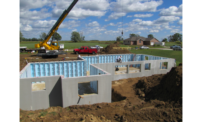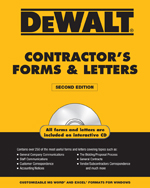Safety Advice: Advice From An Expert Witness
I’ve been employed across the country as an expert witness in a number of construction injury cases over the years. As an OSHA Standards-based consultant, I am typically hired by law firms which represent the injured or deceased worker.

I’ve been employed across the country as an expert witness in a number of construction injury cases over the years. As an OSHA Standards-based consultant, I am typically hired by law firms which represent the injured or deceased worker. Due in some part to my testimony in depositions and on the stand, nine out of the last nine cases in which I’ve testified have been settled either in or out of court in favor of the litigant, my client. Regrettably, seven of these nine clients were professional roofers who fell off or through the roof. Regardless of the details of each case, I have concluded that all nine contractors could have possibly avoided the regrettable loss of a valuable employee, increased workers’ compensation insurance premiums, and expensive litigation procedures if they had only made a few key decisions earlier in their business careers. Here are the leading six recommendations that would certainly make it more difficult for me to prove to a jury that an employer was willfully negligent in his duties to protect his employees under the OSH Act of 1970.
1. Learn OSHA’s rights and obligations for employers and employees. You could think of the situation as a coin with two sides-heads (rights) and tails (obligations). However, the game is definitely rigged. The employer has all the critical obligations while his employees have all of the significant rights to a safe and healthful workplace. The OSHA standards are about sending each worker home safely in his truck, rather than in a cast or a body bag. They are not intended to prevent employers from injury, illness or death, unless they fulfill the role of a player-coach. Contractors should annually attend an OSHA 10-hour Construction Safety class. This is one of the first curves the prosecution may throw at you. If you cannot answer a few well-chosen, pertinent questions regarding the OSHA standards on the witness stand, your chances of avoiding penalty are cut off at the knees. If your disregard for simply knowing your obligations is established early in a trial, it will be a long week for you and your attorney. Ignorance of the safety and health standards offers about as much protection in court as a cellophane hardhat on the job.
2. Perform regular job safety analyses with your crews. For the net cost of a pad of paper and a pen you can invest in one of the most dependable hazard identification and avoidance devices known to man. The best thing about job safety analyses (JSAs) is that they’re simple enough for the employer to use. Most of the moving parts are above the shoulders and between the ears and require no heavy lifting. From JSAs mighty construction empires have been built-and on some pretty solid rock, I might add. Don’t ask too much of your Competent Person (CP) on the job. He or she is only one person. But you’ll find that completing a JSA yourself is about as strenuous as barbequing a steak: You need to pay close attention while you’re doing it, but the results are worth it. Grab a clipboard, dress for work and get out within reach of your crews on a regular basis. Don’t be surprised if some might not even know who you are. Be seen. Get known. And practice what you preach.
3. Develop an effective corporate health and safety program. If the JSA system becomes a highway to greater profits, then your corporate health and safety program (HASP) is where your wheels meet the road. Developed by reviewing your JSAs for hazardous tools, tasks, conditions, and locations, and by reviewing accident reports and interviewing employees on the job, the HASP is meant to “live, breath and bleed” just like your employees. In other words, this document must be a real reflection of the site hazards and controls your employees engage with every shift. If the document which you call your health and safety plan can fold up and easily fit in your shirt pocket, the expert witness will enjoy giving his or her testimony to the jury. Ask your employees to review their HASP annually and make the necessary addendums and corrections according to their suggestions. Honor those who make you your profits by protecting them on the job. If you’ve recognized your employees’ involvement in their own safety on the job, most jurors will find it hard to see you as the unwilling, negligent partner in the deal.
4. Hold an annual two-day corporate safety training event. Make it an exciting event with valuable prizes to be won and good food to eat. Make it informative by hiring interesting public speakers and qualified trainers. Ask a retiree to talk about the state safety and health conditions 40 years ago. Ask an accident survivor to be your luncheon speaker. Ask your vendors to display the newest innovations in workplace safety. Divide your employees into four groups and set the schedule up as a “round robin” with stops at various 45-minute safety topic stations. Give out safety prizes at each station to those who can answer the most questions in a Jeopardy-style quiz on the topic. Give the top three big winners prizes such as weekend for two at a resort, dinner for two at a local restaurant, and gift cards to the runners-up. This is where your cash investments will actually pay off by reducing your insurance overhead. Your employee’s recall of safe work practices may come easier when associated with an enjoyable memory.
When did you first hear the phrase, “What did you know and when did you know it?” Your successful defense in a worker injury case will hinge on employee training, which should take place early and often. Don’t expect your workers to absorb OSHA through the soles of their boots. It doesn’t work that way and never will. The “tribal knowledge” argument may be easily skinned out in front of a jury by a knowledgeable expert witness. Years of documented employee training, however, will effectively steal a lot of ammunition from the prosecution.
5. Verify your competent person is actually competent. If there ever was a “deal breaker” in the courtroom, this is it. Be sure your CP has all of your authority as well as all your responsibility on the jobsite. I have a list of 10 to 12 items I want any employer to agree to if I am to be designated his CP on the job and the employer’s representative within the project’s contract limit lines. Whatever I do or don’t do will affect both of us for the rest of our lives. Every attorney knows both the employer and his designated competent person will be subpoenaed first for trial. In many cases they are reflections of each other under the OSH Act. You must depend on this well-trained and very experienced employee 100 percent in order to keep your site accident-free. So make sure he or she has all of your support and none of your interference. Trust in his/her capability. One compliance officer at the Big Dig in Boston once told me, “If the designated CP can’t spend the boss’s money without his permission, then he’s simply not competent to act promptly.” No arguments from me. If you’ve chosen wisely, you can give your CP all the rope he wants without worrying he’ll hang you both.
6. Issue copies of the OSHA standards to your middle managers. Stop giving your middle management mixed messages like, “Get it done quickly, under budget and don’t have any accidents.” Instead, train them to use the standards as various tools in a gang box of mandatory procedures. Teach mangers to be your on-site employee trainers. When there’s noncompliant behaviors or conditions on site, let them show the workers the standards which they are actually in violation of and why. Review the applicable subparts in weekly toolbox safety talks. Purchase them each a new set of volumes (Part 1910 and 1926) every year to compensate for any changes made in the federal regulations. Make it a part of your job to teach them to become familiar with the applicable subparts and use them daily. The index to the standards is often a suitable checklist for the hazard awareness section of the JSA. Check to see that these volumes are dirty, coffee-stained, dog-eared, and beat up - that way you know they’re being used as they should. If the binding isn’t broken and the cover’s clean as new, then something’s wrong with your team.
The Best Defense
The use of a little imagination may illustrate the undesirable position of defending your actions or inactions in a court of law some three to five years after any workplace accident. Half efforts are next to worthless in front of a well-prepared, OSHA-experienced witness. Ask anyone who has already gone through a trial as a defendant for some cold, hard advice. The day the jury renders its verdict to the court can be the exact point where your future and past divide. There is little self-defense available after the accident if you haven’t first shown a “good faith effort” to provide each worker a type and place of work “free from all recognized hazards” before the accident. If knowledge is power, then believe me, proof of knowledge is always the best defense.

I’ve been employed across the country as an expert witness in a number of construction injury cases over the years. As an OSHA Standards-based consultant, I am typically hired by law firms which represent the injured or deceased worker. Due in some part to my testimony in depositions and on the stand, nine out of the last nine cases in which I’ve testified have been settled either in or out of court in favor of the litigant, my client. Regrettably, seven of these nine clients were professional roofers who fell off or through the roof. Regardless of the details of each case, I have concluded that all nine contractors could have possibly avoided the regrettable loss of a valuable employee, increased workers’ compensation insurance premiums, and expensive litigation procedures if they had only made a few key decisions earlier in their business careers. Here are the leading six recommendations that would certainly make it more difficult for me to prove to a jury that an employer was willfully negligent in his duties to protect his employees under the OSH Act of 1970.
1. Learn OSHA’s rights and obligations for employers and employees. You could think of the situation as a coin with two sides-heads (rights) and tails (obligations). However, the game is definitely rigged. The employer has all the critical obligations while his employees have all of the significant rights to a safe and healthful workplace. The OSHA standards are about sending each worker home safely in his truck, rather than in a cast or a body bag. They are not intended to prevent employers from injury, illness or death, unless they fulfill the role of a player-coach. Contractors should annually attend an OSHA 10-hour Construction Safety class. This is one of the first curves the prosecution may throw at you. If you cannot answer a few well-chosen, pertinent questions regarding the OSHA standards on the witness stand, your chances of avoiding penalty are cut off at the knees. If your disregard for simply knowing your obligations is established early in a trial, it will be a long week for you and your attorney. Ignorance of the safety and health standards offers about as much protection in court as a cellophane hardhat on the job.
2. Perform regular job safety analyses with your crews. For the net cost of a pad of paper and a pen you can invest in one of the most dependable hazard identification and avoidance devices known to man. The best thing about job safety analyses (JSAs) is that they’re simple enough for the employer to use. Most of the moving parts are above the shoulders and between the ears and require no heavy lifting. From JSAs mighty construction empires have been built-and on some pretty solid rock, I might add. Don’t ask too much of your Competent Person (CP) on the job. He or she is only one person. But you’ll find that completing a JSA yourself is about as strenuous as barbequing a steak: You need to pay close attention while you’re doing it, but the results are worth it. Grab a clipboard, dress for work and get out within reach of your crews on a regular basis. Don’t be surprised if some might not even know who you are. Be seen. Get known. And practice what you preach.
3. Develop an effective corporate health and safety program. If the JSA system becomes a highway to greater profits, then your corporate health and safety program (HASP) is where your wheels meet the road. Developed by reviewing your JSAs for hazardous tools, tasks, conditions, and locations, and by reviewing accident reports and interviewing employees on the job, the HASP is meant to “live, breath and bleed” just like your employees. In other words, this document must be a real reflection of the site hazards and controls your employees engage with every shift. If the document which you call your health and safety plan can fold up and easily fit in your shirt pocket, the expert witness will enjoy giving his or her testimony to the jury. Ask your employees to review their HASP annually and make the necessary addendums and corrections according to their suggestions. Honor those who make you your profits by protecting them on the job. If you’ve recognized your employees’ involvement in their own safety on the job, most jurors will find it hard to see you as the unwilling, negligent partner in the deal.
4. Hold an annual two-day corporate safety training event. Make it an exciting event with valuable prizes to be won and good food to eat. Make it informative by hiring interesting public speakers and qualified trainers. Ask a retiree to talk about the state safety and health conditions 40 years ago. Ask an accident survivor to be your luncheon speaker. Ask your vendors to display the newest innovations in workplace safety. Divide your employees into four groups and set the schedule up as a “round robin” with stops at various 45-minute safety topic stations. Give out safety prizes at each station to those who can answer the most questions in a Jeopardy-style quiz on the topic. Give the top three big winners prizes such as weekend for two at a resort, dinner for two at a local restaurant, and gift cards to the runners-up. This is where your cash investments will actually pay off by reducing your insurance overhead. Your employee’s recall of safe work practices may come easier when associated with an enjoyable memory.
When did you first hear the phrase, “What did you know and when did you know it?” Your successful defense in a worker injury case will hinge on employee training, which should take place early and often. Don’t expect your workers to absorb OSHA through the soles of their boots. It doesn’t work that way and never will. The “tribal knowledge” argument may be easily skinned out in front of a jury by a knowledgeable expert witness. Years of documented employee training, however, will effectively steal a lot of ammunition from the prosecution.
5. Verify your competent person is actually competent. If there ever was a “deal breaker” in the courtroom, this is it. Be sure your CP has all of your authority as well as all your responsibility on the jobsite. I have a list of 10 to 12 items I want any employer to agree to if I am to be designated his CP on the job and the employer’s representative within the project’s contract limit lines. Whatever I do or don’t do will affect both of us for the rest of our lives. Every attorney knows both the employer and his designated competent person will be subpoenaed first for trial. In many cases they are reflections of each other under the OSH Act. You must depend on this well-trained and very experienced employee 100 percent in order to keep your site accident-free. So make sure he or she has all of your support and none of your interference. Trust in his/her capability. One compliance officer at the Big Dig in Boston once told me, “If the designated CP can’t spend the boss’s money without his permission, then he’s simply not competent to act promptly.” No arguments from me. If you’ve chosen wisely, you can give your CP all the rope he wants without worrying he’ll hang you both.
6. Issue copies of the OSHA standards to your middle managers. Stop giving your middle management mixed messages like, “Get it done quickly, under budget and don’t have any accidents.” Instead, train them to use the standards as various tools in a gang box of mandatory procedures. Teach mangers to be your on-site employee trainers. When there’s noncompliant behaviors or conditions on site, let them show the workers the standards which they are actually in violation of and why. Review the applicable subparts in weekly toolbox safety talks. Purchase them each a new set of volumes (Part 1910 and 1926) every year to compensate for any changes made in the federal regulations. Make it a part of your job to teach them to become familiar with the applicable subparts and use them daily. The index to the standards is often a suitable checklist for the hazard awareness section of the JSA. Check to see that these volumes are dirty, coffee-stained, dog-eared, and beat up - that way you know they’re being used as they should. If the binding isn’t broken and the cover’s clean as new, then something’s wrong with your team.
The Best Defense
The use of a little imagination may illustrate the undesirable position of defending your actions or inactions in a court of law some three to five years after any workplace accident. Half efforts are next to worthless in front of a well-prepared, OSHA-experienced witness. Ask anyone who has already gone through a trial as a defendant for some cold, hard advice. The day the jury renders its verdict to the court can be the exact point where your future and past divide. There is little self-defense available after the accident if you haven’t first shown a “good faith effort” to provide each worker a type and place of work “free from all recognized hazards” before the accident. If knowledge is power, then believe me, proof of knowledge is always the best defense.
Looking for a reprint of this article?
From high-res PDFs to custom plaques, order your copy today!






